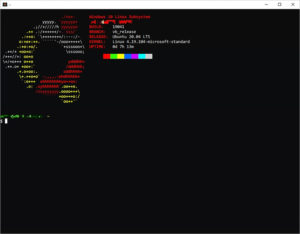

My point was that alacritty will need either tabs, either a working terminal emulator for windows to exist, to be really useful on windows (for powershell and cmd, cygwin and the WSL are a different story). New windows can be created either by using the new `CreateNewWindow`Īction, or with the `alacritty msg create-window` subcommand. That one is a terminal emulator, so you cant use alacritty with it. Terminals has not been refined, making the reliability of this system This point the robustness of the daemon against issues with individual The cost of additional terminal emulators from ~100M to ~6M. Some preliminary tests have shown that for empty terminals, this reduces This makes it possible to add new terminal windows at any time using The event loop has been restructured to handle all window-specificĮvents only by the event processing context with the associated window Process and this "daemon-mode" can also come with the advantage of Platforms like macOS expect all windows to be spawned by the same Previously Alacritty would always initialize only a single terminalĮmulator window feeding into the winit event loop, however some I think multiple windows should be supported natively by Alacritty.

Even when using tmux, it can be desirable to open a second tmux instance for an unrelated session without detaching from the current session. On macOS opening multiple instances of Alacritty fills up the Dock and Application Switcher.Ĭurrently, such behavior must be implemented manually by the user.įrom what I can tell from other issues, using window managers as a replacement for tmux is within Alacritty's scope. (Loading a new instance of Alacritty lasts about 1 second for me vs instant when opening a new window in iTerm.) For a program that prides itself on being the fastest, opening new terminals should be no exception. Load times when opening a new instance of Alacritty are subpar. As far as I can tell, the only way to accomplish this with Alacritty is to open a new instance of the application. With other terminal emulators when I want a new terminal instance, I simply open a new window. I have heard some great things about it, and so I gave it a try. Most fonts have separate files for the bold and italic variations, or they will say ‘Complete’.I use a window manager instead of tmux. Then, I found out that Alacritty a completely new terminal emulator written in Rust had recently added support for Windows.

Bold and Italic point to the same name Notes Once the ‘Regular’ style is working you can repeat this process for the ‘Bold’ and ‘Italic’ sections. Alacritty is very picky about spacing and you may see an error that the file cannot be read if you use the wrong spacing. Double check that your spacing is correct in the config, and that you didn’t make any typos.be sure that you used the correct font name.Try restarting the terminal or window manager.Once you save the file the font should take effect depending on your window manager/Alacritty settings. If you forgot the name, open another terminal and run fc-match from step one. On 114 after ‘family:’ you want to replace ‘monospace’ with the name of the font you want to use. You need to un-comment the lines 105, 107, 114 and 117.

You’ll want to scroll down in the file until you find the section marked ‘Font Configuration’ For me it starts on line 104Įverything is commented out right now. I’m using the micro text editor, but use whichever editor you like to open it: micro ~/.config/alacritty/alacritty.yml


 0 kommentar(er)
0 kommentar(er)
